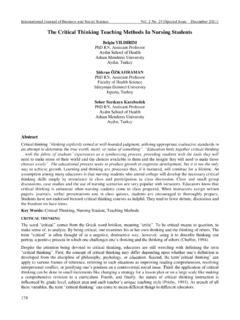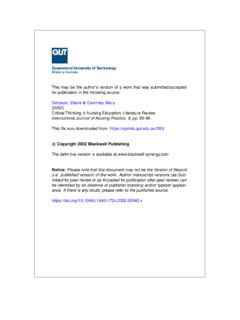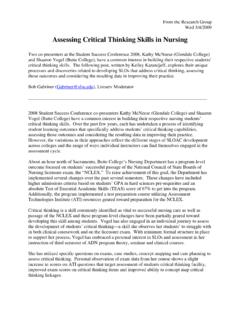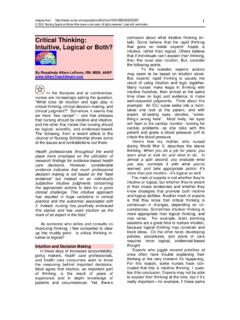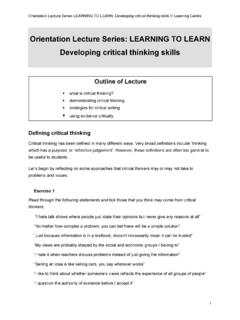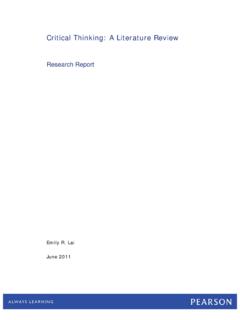Transcription of Evidence-based Approaches to Promoting Critical Thinking
1 Evidence-based Approaches to Promoting Critical ThinkingRosalinda Alfaro- LeFevre, RN, 2008 2008 ! 2008 illiterate of the twenty-first century will not be those who cannot read and write, but those who cannot learn, unlearn, and relearn. Alvin Toffler, author of Future Shock 2008 Alvin Toffler, author of Future ShockYou can download handouts, tools and this powerpoint (for the next two weeks) from: 2008 Great Resource for ToolsSTAFFEDNET LISTSERVS ubscribe info: 2008 Book (2008)CT Book (2008)Saunders/ElsevierSaunders/Elsevier USA: 800 USA: 2008 : 866 CANADA: BookNP Book (2006)(2006) 2008 : 800 USA: 800--638638--3030 3030 CANADA: 800 CANADA: 800--223223--2300 2300 GroundGroundRulesRulesFeel freeTell us about to Parallel ProcessHave fun! (Keep it down.)
2 2008 fun! (Keep it down.)Stay on TaskWe re all experts / We re Both ResponsibleCheck cell phones & egos at the Buster 2008 s Here?Staff nurses?Managers - Administers?Staff Development?School of nursing Faculty? 2008 of nursing Faculty? nursing Home Administtraters?Social Workers?Other?Devil s Advocate 2008 FocusedScheduleWhat s In Your Handouts 2008 OutcomesProgress Worksheet80/20 RulePre-course Assessment 2008 AssessmentExpected OutcomesExpected Outcomes1. Explain why there must be agreement among faculty on how the terms Evidence-based Approaches , Critical Thinking , and nursing processare how to use Evidence-based Critical 2008 how to use Evidence-based Critical Thinking indicators (CTIs) to promote and evaluate Critical Thinking (CT).Expected OutcomesExpected Outcomes3.
3 Identify ways to prioritize what you teach, rather than trying to teach it all . Evidence-based strategies to promote 2008 Evidence-based strategies to promote Critical Thinking in OutcomesExpected Outcomes1. Explain why there must be agreement among faculty on how the terms Evidence-based Approaches , Critical Thinking , and nursing processare defined. 2008 2008 Learning based Learning Your brain can think faster than I can talk You can read faster than I can talk Looking at the same thing from various 2008 Looking at the same thing from various perspectives = increased learning & insightBrainBrain-- based Learning* based Learning* Active participation = retention Humor reduces stress and helps you learn. (Funderstanding) 2008 (Funderstanding)*Hart, L. (2002) Human Brain, Human Learning, 3rd Ed.
4 Covington, WA: Books for Educators, Inc.*On Purpose Associates. Brain- based Learning. Retrieved May 8, 2006: * Think, Pair, Share* 2008 * Developed by Professor Frank Lyman at the University of Maryland in 1981. Read more at: ,_pair, of ConductPeople think better when they like & trust one another. 2008 & trust one Thinking 2008 & Management(PPM)General Principles& CT Skills (CTIs)What s The Big Deal? Bush Goals 2000 (number of people who can think critically will increase). (Scans, 1992) Break the mold schools (students aren t prepared to function in the real world). 2008 to function in the real world). To survive, we must learn very specific skills and strategies to get the results we need. MOST of brain research & CT research has happened in the past 5-10 years Few teachers are familiar with the research & continue to teach in old ways.
5 Learning and using new strategies takes 2008 Learning and using new strategies takes time, but eventually your lives (and your students lives) will be easier ---you ll be amazed at your Between Education & PracticeGap Between Education & Practice_____Growing Rapidly_____Growing Rapidly_____ I am dragging my faculty I feel like we need to BLAST some faculty into the future Practice is going ahead in a speed boat, and 2008 Practice is going ahead in a speed boat, and we re coming along in a canoe (D. Iggy) We need tools to help them assess, diagnose, and predict those at risk NURSES QUOTES We have chain of command problems nursing models are important, but not Approaches are multidisciplinary. 2008 Most of us know nothing of NANDA, NIC, NOC.
6 We tell new grads to leave nursing diagnosis at the QUOTES We re at war over what goes on the left & side of the statement Medical diagnoses can t be listed after the related topart of the statement. It has to be only what the nurse can do independently 2008 can do independently We re at war over replacing assessment tools and care plans with maps. We re required to map in every we don t know why Bus is Leaving the Station & Now it s an Airplane 2008 you be on it?Expected OutcomesExpected Outcomes1. Explain why there must be agreement among faculty on how the terms Evidence-based Approaches , Critical Thinking , and 2008 , Critical Thinking , and nursing processare on the Same Page Is CT the same as NP? Does NP mean NANDA, NIC, NOC? Too much time wasted arguing over meaning Student -faculty Thinking is blocked by no 2008 Student -faculty Thinking is blocked by no Makes the difference between frustration & meaningful learningWhat Does Evidence-based Mean?
7 Many reliable valid studies? Expert consensus? Expert opinion? Support from publications? 2008 Support from publications? Real time studies? Systematic reviews? All of the above? Evidence-based Practice EBP Recognize that no one knows it all Students, nurses, and faculty must be comfortable answering questions like, based on what evidence? ..How do you know?..Is there enough evidence for this for this situation? 2008 EBP is still in its official org identifying teaching-evaluation strategies that are EBP. Educator s EBP Workshop is done (see star model in appendix). NLN doing more Practice (EBP) * Bridges the gap between scientific evidenceand its practical usein the clinical setting. Integrates the following into clinical practice: 1. The best research evidence 2008 The best research evidence2.
8 Opinions from clinical experts3. Patient values and preferences Sackett, D.,et al (2000). Evidence-based medicine: How to practice and teach , Scotland: Churchill, nursing EducationEvidence based nursing Education (EBNE) is integration of Evidence based Practice (EBP) with educator expertiseand learnerneeds and 2008 educator expertiseand learnerneeds and values. (Alfaro-LeFevre, 2008) Evidence-based PracticeAn approach to health care (or teaching) practices in which the nurse, student or or teacher is aware of:1. The evidence that bears on her clinical or 2008 The evidence that bears on her clinical or educational practices2. The strength of that evidence. To the best of our * Evidence-based Practice 2008 *Academic Center for Evidence-based nursing (ACE) Web site. Available at: EDUCATOR COMPETENCIES: CREATING AN Evidence-based PRACTICE FOR NURSE EDUCATORSAUTHOR: Judith A.
9 Halstead, DNS, RN, ANEF, 2008 : Judith A. Halstead, DNS, RN, ANEF, Editor PRICE: NLN Members $ Non-NLN Members $ CT 2008 CT Descriptions A composite of knowledge, skills, & attitudes (Watson and Glaser, 1980). Knowing how to learn, reason, think creatively, generate and evaluate ideas, 2008 , generate and evaluate ideas, see things in the mind's eye, make decisions and solve problems (SCANS, 1992). Reasonable, reflective Thinking that focuses on what to believe or do. (Ennis, 1987) The ability to solve problems by making sense of information using creative, intuitive, logical and analytical mental 2008 and analytical mental the process is continual(Snyder, 1993). The art of Thinking about your Thinking , while you're Thinking , to make it better, more clear, accurate, & defensible.
10 (Paul, 1995) The process of purposeful, self-regulatory the cognitive engine that drives problem solving & decision-making. (Facione & Facione, 1994) 2008 (Facione & Facione, 1994) Knowing how to focus your Thinking to get the results you need (includes intuitive, logical, and creative Thinking ). (Alfaro-LeFevre, 2004) 2008 , Pair, Share 2008 sColor Code Red = PowerBlue = Intimacy 2008 = FunYellow = FunWhite = PeaceCritical Thinking Indicators (CTIs)* Definition:Behaviors that evidence suggests promote Critical Thinking in clinical practice. Give concrete descriptions and examples. 2008 Give concrete descriptions and examples. Listed in context of what s likely to be observed when a nurse is Thinking critically in the clinical setting.*Alfaro-LeFevre, 2004, 20064-Circle CT Model 2008 USE Self improvement / Evaluation Curriculum/Course Evaluation Organizational impact 2008 Risk management Clinical When I see you skipping assessments and making assumptions I know you re not Thinking critically because a first priority in CT is identifying assumptions Example 2008 in CT is identifying assumptions and verifying the When you are able to explain reasons behind procedures I know you are more likely to be Thinking critically because Critical Thinking requires you to understand Example 2008 Thinking requires you to understand underlying reasons and principles so that you can adapt as Process 2008 Does Evidence-based Mean?


